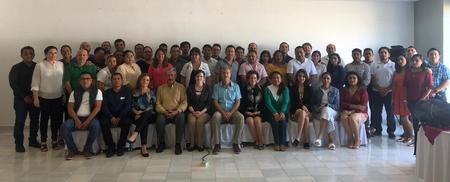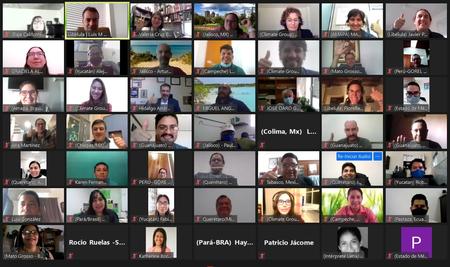As we enter the second year of the Climate Decade and start counting down the weeks to COP26, state and regional governments continue to show leadership and ambition in tackling the greatest challenges faced today.
2020 rightly saw efforts shift to deliver fast and effective responses to the impacts of the COVID-19 pandemic, many of which are still being felt around the world today. However, we know that the climate crisis continues to pose a significant challenge, and we need ambitious target setting and action plans to prevent the worsening of climate impacts we already see all over the world today.
Through the Under2 Coalition’s Climate Pathway Project, six state and regional governments from Latin America have continued their efforts to develop a clearly defined pathway to deliver effective and long-term emissions reductions. Their progress throughout 2020 highlights their commitment to climate leadership, even through a global health crisis.

Reflecting on 2020
Last year, while changes were made to accommodate virtual rather than in-person workshops – and with that came new challenges as teams adapted to remote working – the six governments partaking in the Climate Pathway Project continued to progress with developing their emissions reduction pathways.
Throughout the year, each region worked to set out vision for their pathway, identified relevant stakeholders to involve in pathway development and implementation, proposed emissions reduction targets and priority sectors for decarbonisation, and shared their experiences with other states and regions as the project entered its peer learning phase.
Setting targets and choosing priority sectors
Having long-term targets in place, as well as interim targets as milestones, is crucial to drive achievement of the vision. With the support of the project, the Brazilian regions of Mato Grosso and Amazonas, have proposed 2050 targets of 66% emissions reductions from 2014 levels, which would set them on track for net zero emissions and zero gross emissions by 2068, respectively. Quintana Roo and Querétaro, Mexico, set the most ambitious targets possible for their state of 63% and 66% reductions in CO2 levels by 2050 respectively, with a 2030 target of 21% and 27% emissions reductions from 2010 and 2014 levels respectively. In response to the call for ambitious commitments at the Climate Ambition Summit 2020, São Paulo committed to carbon neutrality by 2050 and Madre de Dios plans actions in line with Peru's emissions reduction ambition.
Following workshops to determine jurisdictional visions and goals for decarbonisation, the regions chose their priority sectors, which for most included the agriculture, forestry and land use (AFOLU) sector plus a combination of other sectors or sub-sectors responsible for a high proportion of jurisdictional emissions. Madre de Dios also decided to prioritise mining and transportation, Querétaro chose to prioritise the energy sector, and São Paulo will have an economy-wide focus after identifying waste management, energy, and industry as priority sectors.
“With the Climate Pathway Project, we are developing a competitive strategy to modify our energy matrix without having a negative impact on the economy.”
“With the Climate Pathway Project, we are developing a competitive strategy to modify our energy matrix without having a negative impact on the economy.”
Identifying relevant stakeholders
Upon determining priority sectors, governments then collected inputs from stakeholders across the sectors about potential mitigation actions that could help reach their targets.
Quintana Roo, for example, consulted a group of key stakeholders from the public, private, and academic sectors, and from indigenous communities that identified key economic sectors to focus on to achieve the state’s emissions reduction targets. The same stakeholder groups will also input towards a catalogue of policy options to reach the targets and develop a comprehensive pathway.
“Reducing emissions requires joint actions by the government, civil society and the agriculture, industry and energy sectors… all should participate and contribute to the implementation of actions that reduce GHG emissions.”
“Reducing emissions requires joint actions by the government, civil society and the agriculture, industry and energy sectors… all should participate and contribute to the implementation of actions that reduce GHG emissions.”
Sharing experiences through peer learning
In June 2020 the project entered its peer learning phase, where project states started to share their experiences with other states and regions around the world as they develop pathways towards their own climate goals.
As part of this work, and to encourage the wider Under2 Coalition network to replicate best practice shared by project regions, over 70 government representatives from 26 Latin American states and regions across Brazil, Colombia, Ecuador, México, and Perú are now taking part in a new virtual training series led by the Climate Pathway Project, in partnership with Libélula, LEDS LAC Secretariat.
In addition to discussing topical issues such as green recovery and vision-setting, at the end of the series participants will complete an initial concept note to guide the development of a decarbonisation pathway for their region.

Looking ahead
- The first Pathways Framework Toolkit for ambitious state and regional governments will be launched in Latin America in February.
- In March, the 26 Latin American regions participating in the project’s virtual training series with Libélula will be ready to begin developing their jurisdictional pathways, having completed a concept note to seek political and financial support.
- By April, all six states will have completed modelling and impact assessments of their prioritised actions.
- Querétaro and Quintana Roo are moving towards the implementation and institutionalisation of their regional pathways, organising high-level meetings with government institutions and the private sector.
- Best practice from the project will be published in a series of case studies of the project states to inform other state and regional governments.
- In the lead-up to COP26, the six project states and teams will continue championing pathways to bridge the gap between ambition and action and promoting best practice.